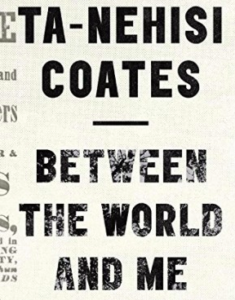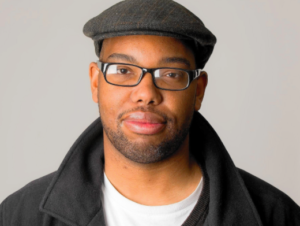Writers Read: Between the World and Me by Ta-Nehisi Coates
 The much talked about Between The World and Me by Ta-Nehisi Coates is about murder—the murder of black people by white people in a country that has thrived, since its inception, on the abuse of black bodies. This thriving is economic, but it is also cultural and, therefore, part of our identity as Americans. Over and over again, Coates describes this culture, providing painful examples with piercingly beautiful language. Coates writes to his son:
The much talked about Between The World and Me by Ta-Nehisi Coates is about murder—the murder of black people by white people in a country that has thrived, since its inception, on the abuse of black bodies. This thriving is economic, but it is also cultural and, therefore, part of our identity as Americans. Over and over again, Coates describes this culture, providing painful examples with piercingly beautiful language. Coates writes to his son:
I propose subjecting our country to an exceptional moral standard. This is difficult because there exists, all around us, an apparatus urging us to accept American innocence at face value and not to inquire too much. And it is so easy to look away, to live with the fruits of our history and to ignore the great evil done in all of our names. But you and I have never truly had the luxury. I think you know (9).
Between The World and Me is an honest open letter from Coates to his fifteen-year-old son, written in the wake of the not-guilty verdict in the Michael Brown case. The book addresses the climate of fear, rage, grief, and sadness around the tradition of violence against black bodies in American society. Through chilling direct prose, Coates describes the vulnerability of black bodies, leaving unearthed the truth that American history has authored this violence, fed it, and normalized it. Coates’s writing draws overlapping circles around his questions about Black culture as it has evolved within this institutionalized violence, and traces his own intellectual and emotional growth within both American culture and the Black community. American history and Black history are part of one another; the violence, the guilt, and the deep belief in race are inexorably linked. But Coates describes a world white people may not know. Or rather, they know it, but they have only ever known it from the perspective of dominance. In this letter, Coates provides a nuanced view, not found in the media. The primary intention of the letter is not to be our teacher, yet it is a teacher—drawing strength from a perfect entangling of intellect and vulnerability, from direct storytelling and fluid, poetic language.
This is the book I want to hand to the person who says they don’t believe in racism, the person who thinks that Black Lives Matter is overly dramatic, the person who sees no connection among Michael Brown, Tamir Rice, Dontre Hamilton, Eric Garner, John Crawford III, Ezell Ford, Dante Parker, Akai Gurley, Rumain Brisbon, Jerame Reid, Tony Robinson, Philip White, Eric Harris, Walter Scott, and Freddy Gray.
Coates describes the mechanism of racism, pointing to white culture’s investment in it. “The people who believe themselves to be white are obsessed with the politics of personal exoneration” (97). This is the book I want to hand to the person who says they don’t believe in racism, the person who thinks that Black Lives Matter is overly dramatic, the person who sees no connection among Michael Brown, Tamir Rice, Dontre Hamilton, Eric Garner, John Crawford III, Ezell Ford, Dante Parker, Akai Gurley, Rumain Brisbon, Jerame Reid, Tony Robinson, Philip White, Eric Harris, Walter Scott, and Freddy Gray—all unarmed black people killed by police during 2014 and 2015.
I got those names through a single Google search. I searched “black men killed by police.” I was fairly confident that I could have access to that list quickly, and that the names would exceed the cases I myself had heard about. That list does not even include the mass murder of black churchgoers last summer or any acts not perpetrated by police but by white civilians who are guaranteed more legal protection than a black person would be if they murdered a white person or child; don’t forget—Tamir Rice was just a child. I want to give this book to those who do not grieve these losses or who grieve them less than the loss of white bodies. Between The World and Me is a gift to American culture from a brilliant writer who was willing to write about his wounds and his pride and his love for us to read. “It is hard to face this. But all our phrasing—race relations, racial chasm, racial justice, racial profiling, white privilege, even white supremacy—serves to obscure that racism is a visceral experience, that it dislodges brains, blocks airways, rips muscle, extracts organs, cracks bones, breaks teeth. You must never look away from this” (10).

Ta-Nehisi Coates, the author. (Photo by Liz Lynch)
Coates writes about the fear weaved into life, masquerading as courage. “The fear was there in the extravagant boys of my neighborhood, in their large rings and medallions, their big puffy coats and full-length, fur collared leathers, which was their armor against their world … I think back on those black boys now and all I see is fear, and all I see is them girding themselves against the ghosts of the bad old days when the Mississippi mob gathered ‘round their grandfathers so that the branches of the black body might be torched, then cut away” (14). Coates’s writing serves as an x-ray, revealing the bones under the culture. We sense the lineage of fear informing everything. He describes the culture of the boys as, “A catalogue of behaviors and garments enlisted to inspire the belief that these boys were in firm possession of everything they desired” (14).
Through chilling direct prose, Coates describes the vulnerability of black bodies, leaving unearthed the truth that American history has authored this violence, fed it, and normalized it.
Coates, Ta-Nehisi. Between The World and Me. New York: Spiegel and Grau. 2015. Print.
Coates, Ta-Nehisi. Between The World and Me. New York: Spiegel and Grau. 2015. Audio Book.


 Meredith Arena is from New York City and resides in Seattle. She is a student in the MFA program at Antioch University Los Angeles. Her work has appeared in SHIFT Magazine, a queer literary arts journal. Meredith Arena is from New York City and resides in Seattle. She is a student in the MFA program at Antioch University Los Angeles. Her work has appeared in SHIFT Magazine, a queer literary arts journal.
Meredith Arena is from New York City and resides in Seattle. She is a student in the MFA program at Antioch University Los Angeles. Her work has appeared in SHIFT Magazine, a queer literary arts journal. Meredith Arena is from New York City and resides in Seattle. She is a student in the MFA program at Antioch University Los Angeles. Her work has appeared in SHIFT Magazine, a queer literary arts journal.


